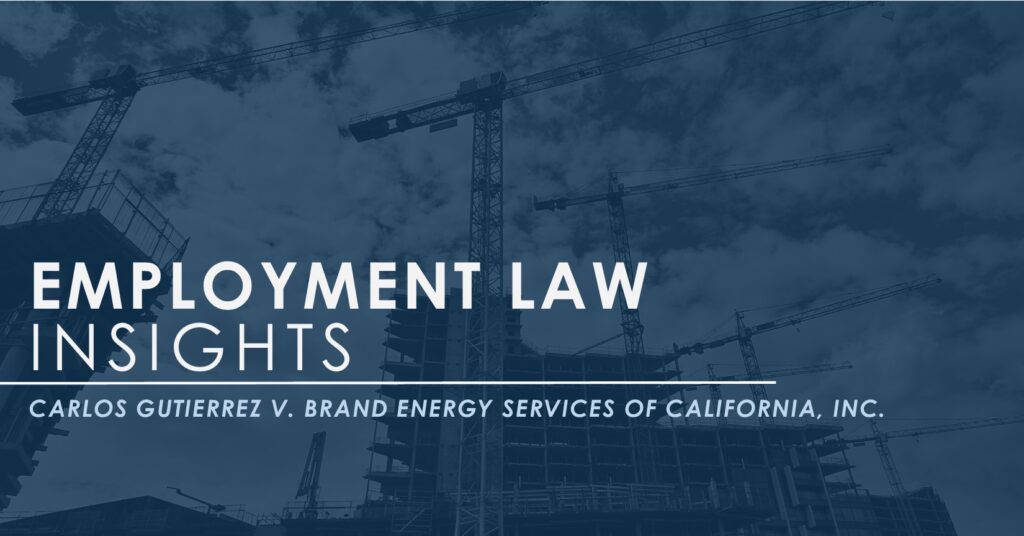By Nicholas Grether, Esq., The Maloney Firm, APC

For this edition of Employment Law Insights, we analyze a recent California appellate court opinion on whether a collective bargaining agreement (“CBA”) allowed an employer to avoid paying employees for employer-required travel time. Carlos Gutierrez v. Brand Energy Services of California, Inc.,(June 16, 2020) Appellate No. A154604, Alameda County Super. Ct. No. RG17846239. A copy of the opinion can be found here. The Court held that the applicable Wage Order and the California Labor Code do not permit an employer to agree in a CBA not to pay employees at least minimum wage for all time worked, including required travel.
.
Plaintiff was Required to Ride the Employer’s Shuttle Bus
.
Plaintiff Carlos Gutierrez (“Plaintiff”) worked at gasoline refineries owned and operated by defendant Brand Energy Services (“Brand”). Plaintiff was a union member and his employment was subject to a CBA. Brand was contracted to erect and dismantle scaffolding at various refineries in Northern California.
.
During one assignment, Plaintiff arrived to the work site approximately 45 minutes before his scheduled start time. After parking his vehicle, he would walk to the refinery gate, scan his badge, and then wait for a shuttle bus to take him to the lunch tent. While at the lunch tent, Plaintiff put on his safety gear and proceeded to a mandatory safety meeting. Plaintiff was required to take the shuttle bus; he was not allowed to take his vehicle to or be dropped off at the lunch tent.
.
Brand considered the start of a shift to be when the safety meeting began. After the workday was completed, Brand paid employees for the time spent traveling from the work site to their vehicles at the end of a shift. This policy was referred to as “in on the employee’s time, out on the Company’s,” was adopted in a Letter of Understanding (“LOU”) and became part of the CBA.1 Plaintiff sued, alleging he should be compensated for the time spent scanning his badge, walking to and waiting for the shuttle bus, traveling by shuttle bus to the lunch tent, and donning his safety gear.
.
The Wage Order for Construction Employees Requires Payment of Minimum Wage For Travel Time
.
Brand countered that Plaintiff’s claims were barred under Industrial Welfare Commission Wage Order No. 16-2001, Section 5(D), which allows for an exemption to Section 5 if employees are covered by a valid CBA. At issue was section 5(A), which provides, “All employer-mandated travel that occurs after the first location where the employee’s presence is required by the employer shall be compensated at the employee’s regular rate of pay or, if applicable, the premium rate . . . .” Accordingly, Brand argued that the CBA exempted it from having to pay the employees for their travel between their parking site and the lunch tent where they attend safety meetings.
.
Plaintiff argued that the right to receive a minimum wage was governed by Section 4 and the presence of an otherwise valid CBA made no difference. The trial court agreed with Brand and granted summary judgment in favor of Brand. Plaintiff appealed.
.
Travel Time on the Shuttle Bus Should be Paid
.
The appellate court (“Court”) explained that, as a general rule, employer-mandated travel time is compensable because an employee is under the employer’s control during that travel. Morillion v. Royal Packing Co., (2000) 22 Cal.4th 575, 587-88. This is consistent with California case law, which focuses primarily on whether an employee is under the employer’s control in determining what time is considered “hours worked” and when employees must be compensated. Here, Plaintiff had to ride the shuttle bus from the refinery entrance to the lunch tent. He was not permitted to be dropped off or use any other form of transportation. The Court thus held that Plaintiff was under Brand’s control, and this time should be compensated as “hours worked.”
.
The Wage Order Does Not Exempt Employers from the Requirement of Paying Minimum Wage 2
.
The Court’s analysis turned on whether Wage Order No. 16-2001, Section 5(D) allowed an employer to agree in a CBA not to pay for employer-required travel time. The Court found that nothing in the Wage Order allowed employees to waive their rights to minimum wages for time that is considered “hours worked.” Noting that the CBA exception was limited to Section 5 of the Wage Order, the Court found that a CBA could only relieve an employer from paying for required travel time at the overtime rate.
.
The Court then noted the inherent conflict between Brand’s interpretation of the Wage Order and Labor Code Section 1194, which prevents employees from working for a rate below the minimum wage. When a conflict occurs between the Wage Orders and the Labor Code, the Labor Code controls. Thus, the Wage Order cannot relieve an employer of its minimum wage requirements. Lastly, the plain language of the CBA exemption did not explicitly apply to Section 4, which requires the payment of minimum wages. For these reasons, the Court ruled that Brand was required to compensate its employees at least the minimum wage for all “hours worked,” including the time Plaintiff spent traveling between the refinery gate and the lunch tent.3
.
What Can Employers Do?
.
This opinion is another example of how California applies its control test to require compensation of employees. Employers should be aware that California courts have consistently applied these laws in favor of employees. Take care to ensure that employees are compensated for every minute they are under your control. Ask yourself who the policy benefits? Here, Brand’s policy requiring the use of shuttle buses benefited Brand since it made it more likely that employees were on time for the start of their workday and did not require Brand to pay the employees for traveling from the parking lot to the lunch tent. If the policy benefits the employer, courts are more likely to find that the employees are not free of the employer’s control. See our recent article on the requirement to pay employees for employer-mandated bag checks for additional discussion of these topics.
.
In addition, do not assume that a CBA or employment agreement will come to your rescue. Make sure that employees comply with your requirements to clock in and clock out as soon as they begin and end work. If you require your employees to use employer-provided transportation, that time must be compensated. Lastly, review your employee handbooks to make sure they are up to date and provide the most accurate information to your employees.
.
Notes:
.
1 Interestingly, the LOU was agreed to after the lawsuit in this case was filed and Brand filed an answer claiming the CBA provided an affirmative defense. The Court did not consider that fact in its analysis, but it may have appeared to the Court that Brand was trying to cover up a violation by amending the CBA.
2 Wage Order 16-2001 applies to employees in certain on-site occupations in the construction, drilling, logging, and mining Industries.
3 In contrast, public employment allows for a valid waiver of the requirement to pay at least the minimum wage when the CBA is approved by the State Legislature and signed by the Governor. The CBA would then be considered a “legislative enactment” approving the agreed-upon terms that is chaptered into law. Stoetzl v. Department of Human Resources, (2019) 7 Cal.5th 718.
.
About the Author:
Nicholas Grether is an employment attorney in the Employment Law Department at The Maloney Firm, APC. If you have questions regarding this alert, you may contact Nicholas Grether at ngrether@maloneyfirm.com.



